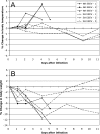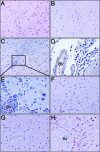Common marmosets (Callithrix jacchus) as a nonhuman primate model to assess the virulence of eastern equine encephalitis virus strains
- PMID: 18614636
- PMCID: PMC2546911
- DOI: 10.1128/JVI.00674-08
Common marmosets (Callithrix jacchus) as a nonhuman primate model to assess the virulence of eastern equine encephalitis virus strains
Abstract
Eastern equine encephalitis virus (EEEV) produces the most severe human arboviral disease in North America (NA) and is a potential biological weapon. However, genetically and antigenically distinct strains from South America (SA) have seldom been associated with human disease or mortality despite serological evidence of infection. Because mice and other small rodents do not respond differently to the NA versus SA viruses like humans, we tested common marmosets (Callithrix jacchus) by using intranasal infection and monitoring for weight loss, fever, anorexia, depression, and neurologic signs. The NA EEEV-infected animals either died or were euthanized on day 4 or 5 after infection due to anorexia and neurologic signs, but the SA EEEV-infected animals remained healthy and survived. The SA EEEV-infected animals developed peak viremia titers of 2.8 to 3.1 log(10) PFU/ml on day 2 or 4 after infection, but there was no detectable viremia in the NA EEEV-infected animals. In contrast, virus was detected in the brain, liver, and muscle of the NA EEEV-infected animals at the time of euthanasia or death. Similar to the brain lesions described for human EEE, the NA EEEV-infected animals developed meningoencephalitis in the cerebral cortex with some perivascular hemorrhages. The findings of this study identify the common marmoset as a useful model of human EEE for testing antiviral drugs and vaccine candidates and highlight their potential for corroborating epidemiological evidence that some, if not all, SA EEEV strains are attenuated for humans.
Figures





References
-
- Aguilar, P. V., R. M. Robich, M. J. Turell, M. L. O'Guinn, T. A. Klein, A. Huaman, C. Guevara, Z. Rios, R. B. Tesh, D. M. Watts, J. Olson, and S. C. Weaver. 2007. Endemic eastern equine encephalitis in the Amazon region of Peru. Am. J. Trop. Med. Hyg. 76293-298. - PubMed
-
- Alice, F. J. 1956. Infecção humana pelo virus “leste” da encefalite equina. Bol. Inst. Biol. Bahia (Brazil) 33-9.
-
- Bastian, F. O., R. D. Wende, D. B. Singer, and R. S. Zeller. 1975. Eastern equine encephalomyelitis: histopathologic and ultrastructural changes with isolation of the virus in a human case. Am. J. Clin. Pathol. 6410-13. - PubMed
Publication types
MeSH terms
Grants and funding
LinkOut - more resources
Full Text Sources

